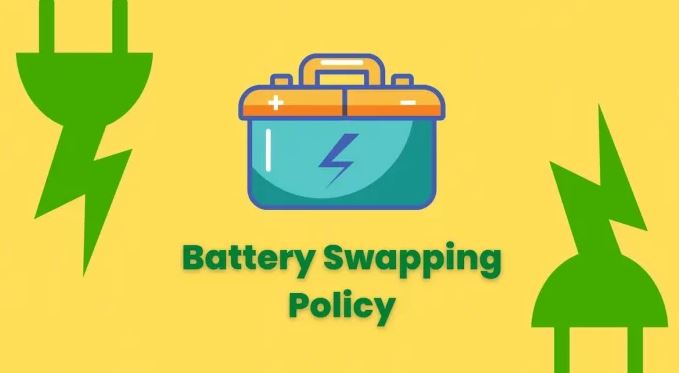NITI Aayog’s Draft Battery Swapping Policy – Key proposals, battery-as-a-service model and the EV safety

From Current Affairs Notes for UPSC » Editorials & In-depths » This topic
IAS EXPRESS Vs UPSC Prelims 2024: 85+ questions reflected
Context: To expedite large-scale adoption of EVs, the government think tank NITI Aayog recently had released the draft battery-swapping policy targeted at electric two-wheelers and three-wheelers, proposing incentives for electric vehicles with swappable batteries, subsidies to firms manufacturing swappable batteries, technical and testing requirements, and reduction of GST, among other things.

What is battery swapping?
- Battery swapping involves exchanging discharged batteries for charged ones, delinking the vehicle and fuel and hence, reducing the upfront cost of the vehicles.
- This provides the flexibility to charge these batteries separately by de-linking charging and battery usage and keeps the vehicle in operational mode with negligible downtime.
- Battery swapping is generally used for smaller vehicles such as two-wheelers and three-wheelers with smaller batteries that are easier to swap, compared to four-wheelers and e-buses, although solutions are emerging for these larger segments as well.
What are some of the key proposals?
Reduce the differential across the tax rates:
- The draft policy has suggested that the GST Council consider reducing the differential across the tax rates on Lithium-ion batteries and electric vehicle supply equipment.
- Currently, the tax rate on the former is 18 per cent, and 5 per cent on the latter.
Offer incentives to electric vehicles with swappable batteries:
- The policy also proposes to offer the same incentives available to electric vehicles that come pre-equipped with a fixed battery to electric vehicles with swappable batteries.
- According to the draft policy, the size of the incentive could be determined based on the kWh (kilowatt-hour) rating of the battery and compatible EV.
- Also, as per the draft policy, an appropriate multiplier may be applied to the subsidy allocated to battery providers to account for the float battery requirements for battery swapping stations in different battery swapping ecosystems.
Contract duration:
- The government will also specify a minimum contract duration for a contract to be signed between EV users and battery providers to ensure they continue to provide battery swapping services after receiving the subsidy.
Public battery charging stations:
- The policy also requires state governments to ensure public battery charging stations are eligible for EV power connections with concessional tariffs.
- It also proposes to bring such stations under existing or future time-of-day (ToD) tariff regimes, so that the swappable batteries can be charged during off-peak periods when electricity tariffs are low.
Ease registration processes:
- Transport Departments and State Transport Authorities will be responsible for easing registration processes for vehicles sold without batteries or for vehicles with battery swapping functionality.
Planning, zoning permissions and land allocation:
- Municipal corporations will be responsible for planning, zoning permissions and land allocation for battery swapping stations.
Unique identification number (UIN):
- The policy also proposes to assign a unique identification number (UIN) to swappable batteries at the manufacturing stage to help track and monitor them.
- Similarly, a UIN number will be assigned to each battery swapping station.
Battery swapping stations:
- It also proposes to install battery swapping stations at several locations like retail fuel outlets, public parking areas, malls, kirana shops and general stores etc.
What is the battery-as-a-service model?
- Battery swapping will fall under the battery-as-a-service (BaaS) business model, and such models would have to ensure interoperability between EVs and batteries for a successful mainstreaming of battery swapping as an alternative.
- As per the policy, given the nascency of battery swapping, interoperability between EV batteries and other components within a battery swapping ecosystem is adequate for eligibility under the policy, if all components within the ecosystem adhere to the technical and performance standards defined for BaaS and battery swapping services.
- Battery-as-a-Service model allows customers to lease batteries as a separate component from cars.
- Leasing the battery saves the upfront purchase cost of an electric vehicle.
- This new service provides battery swapping options that offer a solution to address shorter range issues of an EV.
Does the draft policy talk about EV safety?
- As per the draft policy, to ensure a high level of protection at the electrical interface, a rigorous testing protocol will be adopted to avoid any unwanted temperature rise at the electrical interface.
- The battery management system, which is a software that controls battery functions, will have to be self-certified and open for testing to check its compatibility with various systems, and capability to meet safety requirements.
- According to the draft policy, the batteries shall be tested and certified as per AIS 156 (2020) and AIS 038 Rev 2 (2020) standards for the safety of traction battery packs, as well as additional tests that may be prescribed for swappable batteries which are subject to multiple coupling/decoupling processes at the connectors.
- Additionally, for better protection of assets, swappable batteries will have to be equipped with advanced features like IoT-based battery monitoring systems, remote monitoring, and immobilisation capabilities.
Practice Question for Mains
- Considering the recent draft policy issued by the government think tank NITI Aayog, Discuss the significance of battery swapping. Also, explain the concept of battery as a service. (250 Words, 15 Marks).
If you like this post, please share your feedback in the comments section below so that we will upload more posts like this.

